Rupert Matthews's Blog, page 33
December 18, 2012
The Battle of Crecy - about me
Rupert Matthews is a professional historian with over 150
books, articles and other publications to his name.
To study the Crecy campaign, Rupert followed in the
footsteps of the English army, from St Vaast le Hogue to Caen to Poissy to
Crecy and on to Calais. He spent much time on the battlefields and key
landscapes that had such an impact on events. Having walked over the ground and
viewed it as the commanders of the time did, he has a unique insight into what
those men could have seen and known, and what they could not. He has studied
the weapons and tactics of the time, handling replica weapons and pondering at
first hand the problems raised by using such implements in the tactical formations
of the time. He has also made a study of the less glamourous, but no less
essential, logistical side of medieval warfare.
Rupert is a member of the Battlefields Trust and other
military history organisations.
Rupert Matthews has also written a companion volume to this
book entitled “The Battle of Thermopylae – A Campaign in Context”. This
book is available from Spellmount Publishing and all good book shops.
Rupert was born in 1961 and attended his local grammar
school. He now lives in Surrey, England, with his wife and daughter.
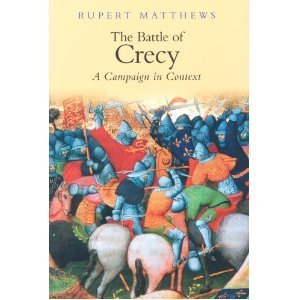
from The Battle of Crecy - a Campaign in Context
Buy your copy HERE
Book Description
Publication Date: 1 May 2007
Rupert Matthews tells the story of the most dramatic
military campaign of the medieval world, a thrilling tale of action,
adventure, mystery and much more. Before the Crecy campaign began,
France was recognised to have the greatest, most powerful and most
modern army in all Christendom. England was thought of as a prosperous
but relatively backward kingdom lying somewhere in the sea off the
European coast. But six hours of bloodshed, slaughter and heroism beyond
imagining changed all that. The pride of France was humbled, her army
destroyed and her king a wounded fugitive fleeing for his life through a
foggy night. This book explains to the general reader the reality of
warfare in the year 1346. It seeks to recreate in our minds the tactics
used in the Crecy Campaign and to put them into the context of the time.
It shows what the weapons were like and how they were used in action.
It describes the tactics of the different military units involved and
how these would have impacted on each other in battle. Crucially, it
takes the reader inside the minds of the commanders to explain what they
did, why they did it and what they hoped to achieve. This is the
second in Spellmount's new series, "Campaign in Context".

Published on December 18, 2012 01:35
December 17, 2012
The formation of RAF Bomber Command
RAF Bomber Command came into existence on 14 July 1935. When
it was born it had a strange mixture of aircraft, organisation and objectives.
Almost at once things got worse when five bomber squadrons were removed from
Bomber Command and sent off to Egypt as a result of aggressive posturing by
Italy’s dictator Benito Mussolini – Italy at that time owned Libya and
areas of Somaliland.
The first head of Bomber Command was Sir John Miles Steel, a
former naval officer who had learned to fly and joined the RAF on its formation
in 1918. His duties in the World War I had included bombing raids and he was a
keen advocate of air power. It was clear by this date that the most likely
opponent in a major war would be Germany, and the RAF was planning to be ready
to face Hitler’s rearmed Luftwaffe by 1942.
A key component of being ready was knowing what tasks the
RAF should, and could, undertake. Until 1934 it had been generally assumed that
bombers would be used primarily to attack strictly military targets fairly
close to base. The idea was drawn from experience of World War I when bombers
had attacked enemy artillery, troop concentrations and supply dumps no more
than a few miles behind the static front lines of the Western Front. There was,
however, added to this the need to have a credible long range bombing force
that could hit Germany itself. This was intended merely as a deterrent to stop
the Germans from bombing British cities, as they had done with limited success
in the closing months of World War I.
One of Steel’s first priorities was to get it agreed what
his command should do in the event of war with Germany. In 1937 a conference
was held between the various armed forces and government. Interestingly Steel
sent as his chief representative a staff officer named Arthur Harris, of whom
much would be heard in future years. The conference covered many aspects of a
prospective war against Germany, but its conclusions about Bomber Command was
that the force should prepare itself to carry out three main tasks. How it
would carry those out was another question entirely.
from "RAF Bomber Command at War" by Rupert Matthews
Buy your copy HERE

Book Description
Publication Date: 30 Nov 2010
Bomber Command of the RAF fought one of the longest, most
gruelling and thankless campaigns of the Second World War. More than
55,000 men and women were killed serving with the Command and the
bombers inflicted severe and ultimately crippling damage to the German
war effort. In this powerful book Rupert Matthews, the son of a Bomber
Command veteran, takes a new look at the exploits of the RAF's strike
force during the Second World War. By looking at the conflict from the
viewpoint of those serving in Bomber Command, he reveals the why and the
how of the Bomber Command campaigns. The abilities of the aircraft and
aircrew are outlined, and the limits this put on operations explained.
This book will help the reader understand the conditions under which the
men of Bomber Command fought, lived and - tragically - so often died.

it was born it had a strange mixture of aircraft, organisation and objectives.
Almost at once things got worse when five bomber squadrons were removed from
Bomber Command and sent off to Egypt as a result of aggressive posturing by
Italy’s dictator Benito Mussolini – Italy at that time owned Libya and
areas of Somaliland.
The first head of Bomber Command was Sir John Miles Steel, a
former naval officer who had learned to fly and joined the RAF on its formation
in 1918. His duties in the World War I had included bombing raids and he was a
keen advocate of air power. It was clear by this date that the most likely
opponent in a major war would be Germany, and the RAF was planning to be ready
to face Hitler’s rearmed Luftwaffe by 1942.
A key component of being ready was knowing what tasks the
RAF should, and could, undertake. Until 1934 it had been generally assumed that
bombers would be used primarily to attack strictly military targets fairly
close to base. The idea was drawn from experience of World War I when bombers
had attacked enemy artillery, troop concentrations and supply dumps no more
than a few miles behind the static front lines of the Western Front. There was,
however, added to this the need to have a credible long range bombing force
that could hit Germany itself. This was intended merely as a deterrent to stop
the Germans from bombing British cities, as they had done with limited success
in the closing months of World War I.
One of Steel’s first priorities was to get it agreed what
his command should do in the event of war with Germany. In 1937 a conference
was held between the various armed forces and government. Interestingly Steel
sent as his chief representative a staff officer named Arthur Harris, of whom
much would be heard in future years. The conference covered many aspects of a
prospective war against Germany, but its conclusions about Bomber Command was
that the force should prepare itself to carry out three main tasks. How it
would carry those out was another question entirely.
from "RAF Bomber Command at War" by Rupert Matthews
Buy your copy HERE

Book Description
Publication Date: 30 Nov 2010
Bomber Command of the RAF fought one of the longest, most
gruelling and thankless campaigns of the Second World War. More than
55,000 men and women were killed serving with the Command and the
bombers inflicted severe and ultimately crippling damage to the German
war effort. In this powerful book Rupert Matthews, the son of a Bomber
Command veteran, takes a new look at the exploits of the RAF's strike
force during the Second World War. By looking at the conflict from the
viewpoint of those serving in Bomber Command, he reveals the why and the
how of the Bomber Command campaigns. The abilities of the aircraft and
aircrew are outlined, and the limits this put on operations explained.
This book will help the reader understand the conditions under which the
men of Bomber Command fought, lived and - tragically - so often died.

Published on December 17, 2012 02:03
December 14, 2012
The reason for rthe Siege of Bamburgh 1464
The crushing defeat at Hexham and ruthless executions that followed served to destroy the Lancastrian cause in northern England, the last bastion of their hopes. A few days after the battle the Lancastrian knight Sir William Tallboys was discovered hiding in a coal mine together with a vast quantity of gold and silver coin – the main treasure of the Lancastrians.
Edward IV, Yorkist King of England, came north to accept the surrenders of those now willing to come to terms, while his cousin and leading commander the Earl of Warwick took the Yorkist army to overcome those who were not. One by one the Lancastrian castles surrendered to Warwick who, on Edward’s insistence, was offering generous terms of surrender. Only Sir Ralph Grey, who had betrayed Edward more than once, was exempted from such offers of peace. And all across the north of England Yorkist scouts, soldiers and agents searched for the fugitive King Henry VI, who had not been seen or heard of since leaving Bywell Castle the day after the Battle at Hexham.
In June Warwick and his army appeared before Bamburgh Castle.
from BATTLEFIELD WALKS IN NORTHUMBERLAND by Rupert Matthews
Buy your copy HERE

Book Description
Publication Date: 1 April 2008 | Series: Battlefield Walks
Northumberland is one of the most beautiful counties in
England, but also one of the most fought over. It has seen countless
skirmishes, some very bloody, between invading and looting Scots and the
avenging English families of the Percies, Umfravilles and Nevilles.
Rupert Matthews, ‘the History Man’, presents fifteen guided walks
around the battlefields of Northumberland. He provides an account of
events as they unfolded on the ground along with full background and
context. His expertise, descriptive powers and lively enthusiasm bring
the drama of history vividly to life.

Edward IV, Yorkist King of England, came north to accept the surrenders of those now willing to come to terms, while his cousin and leading commander the Earl of Warwick took the Yorkist army to overcome those who were not. One by one the Lancastrian castles surrendered to Warwick who, on Edward’s insistence, was offering generous terms of surrender. Only Sir Ralph Grey, who had betrayed Edward more than once, was exempted from such offers of peace. And all across the north of England Yorkist scouts, soldiers and agents searched for the fugitive King Henry VI, who had not been seen or heard of since leaving Bywell Castle the day after the Battle at Hexham.
In June Warwick and his army appeared before Bamburgh Castle.
from BATTLEFIELD WALKS IN NORTHUMBERLAND by Rupert Matthews
Buy your copy HERE

Book Description
Publication Date: 1 April 2008 | Series: Battlefield Walks
Northumberland is one of the most beautiful counties in
England, but also one of the most fought over. It has seen countless
skirmishes, some very bloody, between invading and looting Scots and the
avenging English families of the Percies, Umfravilles and Nevilles.
Rupert Matthews, ‘the History Man’, presents fifteen guided walks
around the battlefields of Northumberland. He provides an account of
events as they unfolded on the ground along with full background and
context. His expertise, descriptive powers and lively enthusiasm bring
the drama of history vividly to life.

Published on December 14, 2012 02:07
December 7, 2012
The Triumphs of Commodus
When the Emperor Marcus Aurelius died in March 180 he and his son Commodus were two years into a gruelling campaign against the German tribes north of the Danube frontier. Commodus’ first action was to have himself proclaimed Emperor by his army. His second was to declare that the war was won and that he would celebrate a Triumph.
Leaving his subordinates to patch up a peace treaty with the barbarians, Commodus travelled back to Rome to hold his Triumph in October. All the trappings of a traditional Triumph were observed. Captive Germans were herded in the procession, captured weapons and looted treasures were displayed in carts and soldiers carried paintings representing the events of the war. Commodus painted his face crimson and donned purple robes embroidered with golden palms of victory before riding in his chariot along the usual route through the city. And, as usual, a slave stood beside him holding the laurel wreath of victory above his head and whispering “Remember you are mortal.” More unusual was the fact that from time to time Commodus turned round to kiss the slave, his homosexual lover Saoterus. The Romans may have been impressed by the Triumph, but they were displeased by the open display of what most considered a vice.
Commodus himself, however, loved every minute of the celebrations, so much so that two years later he took advantage of a minor victory over the Picts in northern Britain to take the title Britannicus and hold another Triumph. This time there were neither prisoners nor booty on hand. Commodus rounded up some British slaves living in Rome and dressed them in Pictish costume to play the role of the conquered army in the procession. The following year, lacking even a minor victory to give an excuse for a Triumph, Commodus had himself proclaimed Emperor all over again and held celebratory games.
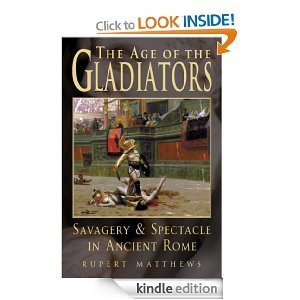
from The Age of Gladiators by Rupert Matthews
Buy your copy HERE
Product Description
The great spectacles of ancient Rome have become proverbial for
their cruelty, bloodlust and glory. In the arena, the games were savage
and brutal. Gladiators fought each other to the death, wild animals were
put to fight each other and criminals were executed by barbaric means.
Military
victories were marked by the Triumphs when generals paraded through the
city, the defeated were sacrificed to the gods and food and wine was
offered free of charge on a lavish scale. Meanwhile the citizens
received free bread to prevent hunger and the riots it could provoke.
The
Age of the Gladiators looks at these savage spectacles and traces their
development from entertainment to hysterical obsession until their
eventual decline and disappearance, and explains how they still have
influence on contemporary public life.


Leaving his subordinates to patch up a peace treaty with the barbarians, Commodus travelled back to Rome to hold his Triumph in October. All the trappings of a traditional Triumph were observed. Captive Germans were herded in the procession, captured weapons and looted treasures were displayed in carts and soldiers carried paintings representing the events of the war. Commodus painted his face crimson and donned purple robes embroidered with golden palms of victory before riding in his chariot along the usual route through the city. And, as usual, a slave stood beside him holding the laurel wreath of victory above his head and whispering “Remember you are mortal.” More unusual was the fact that from time to time Commodus turned round to kiss the slave, his homosexual lover Saoterus. The Romans may have been impressed by the Triumph, but they were displeased by the open display of what most considered a vice.
Commodus himself, however, loved every minute of the celebrations, so much so that two years later he took advantage of a minor victory over the Picts in northern Britain to take the title Britannicus and hold another Triumph. This time there were neither prisoners nor booty on hand. Commodus rounded up some British slaves living in Rome and dressed them in Pictish costume to play the role of the conquered army in the procession. The following year, lacking even a minor victory to give an excuse for a Triumph, Commodus had himself proclaimed Emperor all over again and held celebratory games.

from The Age of Gladiators by Rupert Matthews
Buy your copy HERE
Product Description
The great spectacles of ancient Rome have become proverbial for
their cruelty, bloodlust and glory. In the arena, the games were savage
and brutal. Gladiators fought each other to the death, wild animals were
put to fight each other and criminals were executed by barbaric means.
Military
victories were marked by the Triumphs when generals paraded through the
city, the defeated were sacrificed to the gods and food and wine was
offered free of charge on a lavish scale. Meanwhile the citizens
received free bread to prevent hunger and the riots it could provoke.
The
Age of the Gladiators looks at these savage spectacles and traces their
development from entertainment to hysterical obsession until their
eventual decline and disappearance, and explains how they still have
influence on contemporary public life.

Published on December 07, 2012 01:50
December 6, 2012
Early Gladiatorial Arenas
Market places
Until around 30bc, there were no purpose built arenas. Fights took place in market squares or in the forum. A central area was cleared as a fighting space while spectators watched from shops, buildings or from temporary stands.
The First Arena
The first arena built in Rome specifically for gladiator fights was erected in 29bc by the politician Titus Satilius Taurus. Because he wanted to flatter the emperor Augustus, Taurus had the name of Augustus carved over the entrance. It worked, Taurus had a long and distinguished career.
Arena Layout
The basic layout of all gladiatorial arenas was the same. In the middle was the sand covered fighting area, which was oval in shape. This was surrounded by a wall about four metres tall so that wild animals could not jump out. Above the wall sat the audience. The editor, the organiser of the games, sat in a special stand on the shady north side of the arena.
from "Action File Gladiators" by Rupert Matthews
Buy your copy HERE
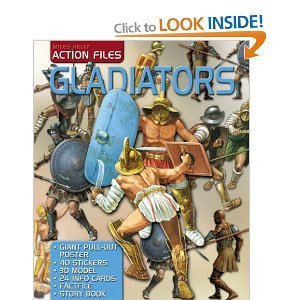
Book Description
Publication Date: 1 Aug 2008 | Series: Action Files
Action files gladiators lets you witness the awesome
spectacle of gladiators in battle in this fully interactive book. Packed
with fascinating facts and activities, it contains all you ever wanted
to know about the warriors of Rome.


Until around 30bc, there were no purpose built arenas. Fights took place in market squares or in the forum. A central area was cleared as a fighting space while spectators watched from shops, buildings or from temporary stands.
The First Arena
The first arena built in Rome specifically for gladiator fights was erected in 29bc by the politician Titus Satilius Taurus. Because he wanted to flatter the emperor Augustus, Taurus had the name of Augustus carved over the entrance. It worked, Taurus had a long and distinguished career.
Arena Layout
The basic layout of all gladiatorial arenas was the same. In the middle was the sand covered fighting area, which was oval in shape. This was surrounded by a wall about four metres tall so that wild animals could not jump out. Above the wall sat the audience. The editor, the organiser of the games, sat in a special stand on the shady north side of the arena.
from "Action File Gladiators" by Rupert Matthews
Buy your copy HERE

Book Description
Publication Date: 1 Aug 2008 | Series: Action Files
Action files gladiators lets you witness the awesome
spectacle of gladiators in battle in this fully interactive book. Packed
with fascinating facts and activities, it contains all you ever wanted
to know about the warriors of Rome.

Published on December 06, 2012 10:48
December 5, 2012
The Evening Hate 1915
Artillery placed hundreds of yards behind the trenches would fire shells at the enemy throughout the day. They would aim at trenches, or at roads and railways behind the lines.
The artillery often opened fire in the first few hours of darkness when enemy soldiers would be going on patrol, or moving from the front line to the reserves. This became known as “the evening hate”.
from "1000 Facts About World War I" by Rupert Matthews
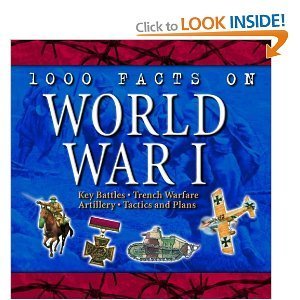
Buy your copy here
Product details
Hardcover: 224 pages
Publisher: Miles Kelly Publishing Ltd (1 Mar 2006)
Language: English
ISBN-10: 1842366777
ISBN-13: 978-1842366776
Product Dimensions:
18.8 x 17.8 x 3 cm
Average Customer Review: Be the first to review this item
Amazon Bestsellers Rank:
540,837 in Books (See Top 100 in Books)
Would you like to update product info , give feedback on images , or tell us about a lower price ?
Product Description
Synopsis
Helps explore the intriguing complexities of World War I. This
book talks about how and why the war took place, and who led each
country's army through every battle. It describes, in detail, the troop
movements, trench warfare and key battles, along with the development of
war machinery.


The artillery often opened fire in the first few hours of darkness when enemy soldiers would be going on patrol, or moving from the front line to the reserves. This became known as “the evening hate”.
from "1000 Facts About World War I" by Rupert Matthews

Buy your copy here
Product details
Hardcover: 224 pages
Publisher: Miles Kelly Publishing Ltd (1 Mar 2006)
Language: English
ISBN-10: 1842366777
ISBN-13: 978-1842366776
Product Dimensions:
18.8 x 17.8 x 3 cm
Average Customer Review: Be the first to review this item
Amazon Bestsellers Rank:
540,837 in Books (See Top 100 in Books)
Would you like to update product info , give feedback on images , or tell us about a lower price ?
Product Description
Synopsis
Helps explore the intriguing complexities of World War I. This
book talks about how and why the war took place, and who led each
country's army through every battle. It describes, in detail, the troop
movements, trench warfare and key battles, along with the development of
war machinery.

Published on December 05, 2012 01:31
December 4, 2012
The Roman Underworld
The Roman Underworld
The Romans believed that the souls of the dead were grabbed by two spirits, one pulling form the front, the other pushing from behind. These led the soul deep underground to the land of Hades to meet the god Dis Pater, who would decide the souls fate.
Dis Pater met the soul and read out from a scroll the deeds that the person had performed while alive. If there were more deeds that pleased the gods than displeased them, the soul was allowed to enter Hades.
If a person had committed more acts that displeased the gods than had pleased them, the soul would be handed over to the goddess Tuchulcha and her husband Charon. Tuchulcha had eyes of fire, pointed ears and snakes wrapped around her body. She and Charon enjoyed torturing people.
Februus was the god who caused death. He walked across the earth searching out those whose lives were coming to an end. The second month of the year was sacred to him, and is still called February.


The Romans believed that the souls of the dead were grabbed by two spirits, one pulling form the front, the other pushing from behind. These led the soul deep underground to the land of Hades to meet the god Dis Pater, who would decide the souls fate.
Dis Pater met the soul and read out from a scroll the deeds that the person had performed while alive. If there were more deeds that pleased the gods than displeased them, the soul was allowed to enter Hades.
If a person had committed more acts that displeased the gods than had pleased them, the soul would be handed over to the goddess Tuchulcha and her husband Charon. Tuchulcha had eyes of fire, pointed ears and snakes wrapped around her body. She and Charon enjoyed torturing people.
Februus was the god who caused death. He walked across the earth searching out those whose lives were coming to an end. The second month of the year was sacred to him, and is still called February.

Published on December 04, 2012 08:07
November 29, 2012
Plato's Academy
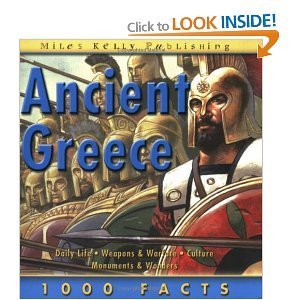 Plato was a pupil of Socrates. He taught that certain things - such as good, evil and justice - exist outside of human senses and continue unchanged forever.
Plato was a pupil of Socrates. He taught that certain things - such as good, evil and justice - exist outside of human senses and continue unchanged forever. In The Republic, a series of ten books, Plato set out what he thought was a perfect system of government. He said there should be a rigid class system and that the ruler should be a philosopher-king who was wise enough to rule in the interests of all.
The education that the philosopher-king should receive was described as being based on physical exercise, artistic appreciation and philosophy.
After travelling to many different Greek cities, Plato produced a new book called Laws. In this he abandoned the idea of a philosopher-king and instead said there should be joint ownership of all property by the citizens.
When he returned to Athens, Plato bought a field called Academus that lay just outside Athens. Plato set up a school called the Academy in the field where he taught his ideas.
Plato died in 347bc, but his Academy survived until ad529. Thousands of men were educated there and Plato's ideas have remained important down to the present day.
from "100 Facts About Ancient Greece" by Rupert Matthews
Buy your copy HERE

Published on November 29, 2012 00:56
November 28, 2012
The madness of Henry VI and Wars of the Roses
Henry VI, son of the heroic Henry V was a very different kind of man. He was gentle and good-natured, but was simple-minded to an extent that several of his contemporaries thought he was mad. It was his misfortune to be king during the darkest days in England for many generations.
Henry came to the throne when he was just nine months old. His uncle John, Duke of Bedford was made Regent of the English territory in France and proved to be an able and efficient governor. The boy-king’s other uncle, Humphrey, Duke of Gloucester, was regent in England but proved himself to be unreliable and arrogant.
Henry came of age in 1438 just in time to lose most of his French lands after defeat at the Battle of Formigny. In England the mighty nobles were arguing with each other. Cardinal Beaufort and his nephews Somerset and Suffolk led the Lancastrian party supported by Margaret, Queen to the simple Henry VI. Humphrey, Duke of Gloucester, and Richard, Duke of York, led the Yorkists with the support of the wealthy Richard Neville, Earl of Warwick. For many years the Lancastrians dominated the government by bullying poor Henry VI to sign acts in their favour, and they even organised the murder of Gloucester.
In 1455 the Lancastrians summoned a council of nobles on the pretext of protecting the king against traitors. They did not, however, invited the Duke of York or the Earl of Warwick. Realising that they were the supposed traitors, York and Warwick called on their supporters and soon had a force of 3,000 men mustered at St Albans. They were met by 2,000 Lancastrians and a savage street battle broke out. York and Warwick won the day and captured the king. It was just the first of many battles in what became known as the Wars of the Roses, for York had a white rose for his badge and the Lancastrians adopted a red rose.
The Duke of York took over the government and ruled in Henry’s name. York struggled to impose some form of order and honesty on a government for too long dominated by corrupt and self-seeking noblemen. He also tended to favour the new, rising class of merchants and tradesmen over the old landed aristocracy. This angered many powerful nobles, who began to speak in support of Queen Margaret.
It was only the first round...

Henry came to the throne when he was just nine months old. His uncle John, Duke of Bedford was made Regent of the English territory in France and proved to be an able and efficient governor. The boy-king’s other uncle, Humphrey, Duke of Gloucester, was regent in England but proved himself to be unreliable and arrogant.
Henry came of age in 1438 just in time to lose most of his French lands after defeat at the Battle of Formigny. In England the mighty nobles were arguing with each other. Cardinal Beaufort and his nephews Somerset and Suffolk led the Lancastrian party supported by Margaret, Queen to the simple Henry VI. Humphrey, Duke of Gloucester, and Richard, Duke of York, led the Yorkists with the support of the wealthy Richard Neville, Earl of Warwick. For many years the Lancastrians dominated the government by bullying poor Henry VI to sign acts in their favour, and they even organised the murder of Gloucester.
In 1455 the Lancastrians summoned a council of nobles on the pretext of protecting the king against traitors. They did not, however, invited the Duke of York or the Earl of Warwick. Realising that they were the supposed traitors, York and Warwick called on their supporters and soon had a force of 3,000 men mustered at St Albans. They were met by 2,000 Lancastrians and a savage street battle broke out. York and Warwick won the day and captured the king. It was just the first of many battles in what became known as the Wars of the Roses, for York had a white rose for his badge and the Lancastrians adopted a red rose.
The Duke of York took over the government and ruled in Henry’s name. York struggled to impose some form of order and honesty on a government for too long dominated by corrupt and self-seeking noblemen. He also tended to favour the new, rising class of merchants and tradesmen over the old landed aristocracy. This angered many powerful nobles, who began to speak in support of Queen Margaret.
It was only the first round...

Published on November 28, 2012 03:57
November 26, 2012
What do the pub signs mean?
[image error]Up and down the country of Britain pubs, or more properly public houses, announce their presence with bright and colourful signs. The history of the pub sign is one of the quintessentially British stories.
The British pub has a long and honoured history. Starting as the local ale house, the pub has developed into more of a social centre for villages and town districts than a simple place for drinking. Pubs have darts teams and football teams, they collect money for charity, they provide places for courting couples to meet and for old men to escape their wives. Everything, in short, that the local resident might need. And the pub provides for travellers and passersby as well with food and drink, toilets, parking for cars and bicycles and sometimes a place to sleep.
The signs advertising the pub today generally follow a set pattern so that a traveller can recognise a pub whatever part of the country they happen to be in, and it was always so. In medieval times an alehouse would hang a small bush outside the front door to show its trade. In towns the bushes were not so readily available so by Tudor times an empty barrel did service.
At about the same time the custom arose of placing easily recognised symbols outside business premises. This enabled a customer to find the premises he was seeking in a busy and crowded street - there being no such thing as house numbers in those days. A candlemaker, for instance, might be found at the sign of the candlestick.
Pubs, for some reason, took to displaying heraldic symbols such as red lions or white harts. Although shops and businesses have largely dropped their signs, the pubs have kept them. A great many retain their heraldic symbols, often showing a knight’s shield on the pub sign as well as the charge itself. In some places the origin of the symbol is obvious. The Onslow Arms in Clandon, Surrey, for instance displays the heraldic arms of the Onslow family, the local large landowners. Others are scarcely less clear, the Bear and Ragged Staff being the symbol of the once powerful Earls of Warwick.

Published on November 26, 2012 01:17



